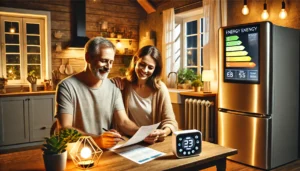Key strategies to consider:
- Seal Drafts and Insulate: Check for drafts around windows and doors and use weatherstripping or caulking to seal leaks. Proper insulation in walls and attics helps maintain indoor temperatures and reduces heating and cooling costs.
- Upgrade to LED Lighting: Replace traditional incandescent bulbs with energy-efficient LED lights. LEDs consume up to 80% less energy and last longer, offering substantial savings over time.
- Install Smart Thermostats: A smart thermostat allows you to program temperature settings and optimize energy use. Adjusting the temperature by just a few degrees when you’re away can lower energy costs significantly.
2. Adopt Energy-Saving Habits
Simple behavioral changes in your daily routine can have a profound impact on reducing your energy bill.
Practical habits to adopt:
- Unplug Unused Devices: Electronics continue to draw power even when turned off. Unplug devices when not in use or use power strips to easily disconnect multiple appliances at once.
- Efficient Laundry Practices: Wash clothes in cold water and line-dry whenever possible. Modern detergents clean effectively in cold water, and air-drying reduces dryer energy consumption.
- Limit Peak Hour Usage: Energy rates can be higher during peak hours. Run major appliances like dishwashers and washing machines during off-peak times to save on energy costs.
3. Invest in Energy-Saving Appliances
Energy-efficient appliances may require an upfront investment but lead to significant long-term savings.
Key appliances to upgrade:
- Energy Star-Certified Devices: Look for appliances with the Energy Star label, which indicates higher energy efficiency standards. Common items include refrigerators, washing machines, and water heaters.
- High-Efficiency HVAC Systems: Upgrade to a high-efficiency heating and cooling system to cut energy consumption while maintaining home comfort.
- Advanced Power Strips: These automatically shut off power to devices not in use, reducing “phantom load” energy consumption.
4. Utilize Renewable Energy Solutions

Incorporating renewable energy into your household reduces dependence on traditional power sources and lowers energy costs.
Options to explore:
- Solar Panels: Installing solar panels generates clean electricity and can significantly reduce or eliminate energy bills over time. Many regions offer tax incentives for solar installations.
- Wind Energy: If your location allows, consider small wind turbines to supplement household power.
- Community Solar Programs: If installing panels isn’t feasible, check for community solar projects where you can purchase a share of solar energy and receive credits on your bill.
5. Conduct Regular Maintenance Checks
Routine maintenance ensures your home remains energy-efficient and prevents costly repairs.
Maintenance tasks to prioritize:
- HVAC System Servicing: Regularly clean or replace air filters and schedule annual professional inspections to maintain system efficiency.
- Water Heater Optimization: Lower the water heater temperature to 120°F (49°C) to reduce energy consumption while still providing hot water.
- Ductwork Inspection: Leaky ductwork wastes energy. Inspect and seal ducts to prevent loss and improve heating and cooling efficiency.
Want even more ways to save energy? Dive deeper into advanced strategies: Learn More
Conclusion
Reducing your energy bill involves a combination of smart habits, energy-efficient upgrades, and routine maintenance. By making small but impactful changes, you can lower energy costs while contributing to a more sustainable future. Start with one or two strategies and gradually incorporate more to maximize your savings over time.
Ready to take your energy savings to the next level? Explore our advanced techniques and discover even more ways to cut costs while maintaining a comfortable lifestyle.



